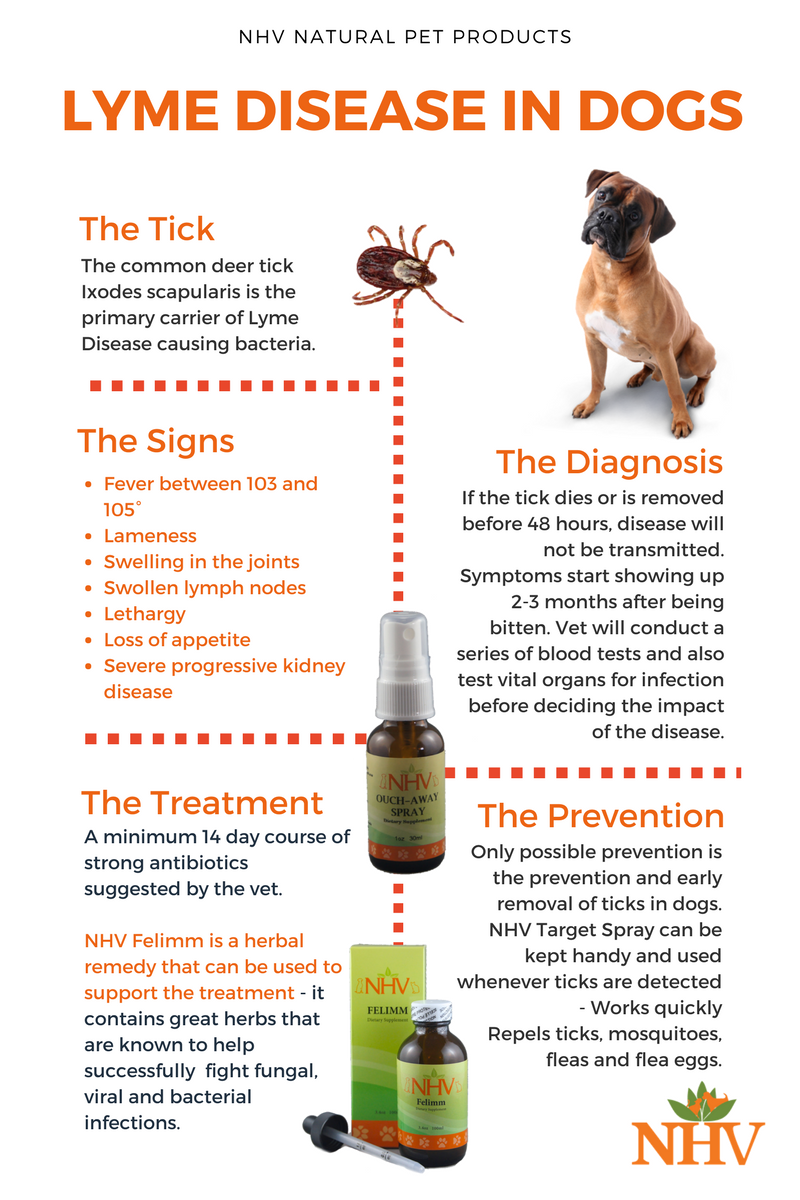Recovery And Management Of Lyme Disease In Dogs
You can expect to see improvement in mild cases of Lyme disease in dogs 3 to 5 days into antibiotic therapy. Severe cases may take longer and can be fatal if kidney damage is too advanced.
Antibiotics do not always eliminate Lyme disease. Dogs infected with Lyme disease will be prone to recurrence of the infection in the future, but antibiotics can be used again to treat the condition.
Owners can help manage their dogs condition by complying with their veterinarians advice and following the instructions on the medication. Learning to recognize the signs of Lyme disease will also help owners get their dogs started on medication as soon as possible to prevent serious side effects in the future.
Lyme Disease In Dogs: Symptoms Diagnosis & Treatment
Unlike humans, dogs do not develop a circular rash upon being infected with Lyme disease. Symptoms of Lyme disease in dogs include:
Lyme Disease in Your Area
To learn about the prevalence of Lyme disease in your state or country, see the following resources:
- Australia: Lyme disease is very rare in Australia if it exists at all. for more information.
Diagnosis Of Lyme Borreliosis In Animals
-
Based on a combination of history, clinical signs, laboratory data, response to therapy, and exclusion of other diseases
-
Serology is important, but positive results have a low positive predictive value of clinical disease
-
Culture and PCR do not reliably detect spirochetes
-
Cytology and histopathology of affected tissues may show characteristic inflammatory changes
A diagnosis of Lyme borreliosis is generally reached through the exclusion of other diseases, in tandem with a history of exposure to ticks, clinical signs, supporting laboratory data, and response to therapy. Because clinical signs are nonspecific, other diseases may mimic the signs of Lyme borreliosis. Moreover, most infected animals are asymptomatic, so a positive test result for B burgdorferi has a low positive predictive value for clinical disease. In other words, a positive test neither demonstrates that current clinical signs are caused by infection with B burgdorferi, nor suggests that the animal is likely to develop clinical illness in the future. Thus, a positive test result in a clinically ill animal may be an incidental finding.
The standard procedure for antibody detection is a two-tiered approach in which samples are screened with a sensitive rapid assay and only positively reacting samples are rechecked with specific confirmatory tests. Although quantitative antibody assays are available to test for C6, titer magnitude is a poor predictor of current or future illness.
Also Check: What Are The First Symptoms Of Lyme Disease
Is There A Vaccine That Will Protect My Dog From Lyme Disease
A safe and generally effective vaccine is available for protecting dogs against Lyme disease. This vaccine is initially given twice, at two- to four-week intervals.
“Annual revaccination is necessary to maintain immunity.”
Annual revaccination is necessary to maintain immunity. Vaccination against Lyme disease will be determined by your pet’s lifestyle and individual risk assessment. Be sure to discuss any questions you may have regarding the type and frequency of vaccination with your veterinarian.
Treatment Of Lyme Borreliosis In Animals

-
A long course of antibiotics is indicated to treat infection in clinically ill animals
-
Symptomatic therapy should be directed toward the affected organ system and toward pain management
-
Immunosuppressive therapy is indicated in the case of infection-related autoimmune reactions
-
Some animals may remain seropositive after successful treatment
Antibiotic therapy is indicated in all animals with clinical signs attributed to Lyme borreliosis. Treatment of healthy seropositive animals is problematic because of the inability to monitor response to treatment and the potential for adverse drug effects. Antimicrobials in the tetracycline and beta-lactam families have been shown to be effective in treating Lyme borreliosis in dogs and horses. A long course of antibiotics is indicated. Chronic infection in dogs and horses is not well documented, so the utility or efficacy of treatment beyond 4 weeks is unknown. Symptomatic therapy directed toward the affected organ system and clinicopathologic abnormalities is also important.
Quantitative C6 antibody assays are sometimes performed before and after treatment to monitor response to therapy, although titers do not always decrease after treatment, and some animals remain seropositive. Successful treatment is therefore focused on the resolution of clinical signs rather than serologic data. An increased titer after treatment may represent a relapse or reinfection.
You May Like: How Long To Treat Lyme Disease
How Is Lyme Disease Diagnosed In Dogs
A diagnosis of Lyme disease is usually made based upon a history of being in an endemic area, signs of arthritis, and favorable response to treatment.
A blood test can measure antibodies to the bacteria, but many dogs that live in endemic regions will have a positive result. A positive only confirms the dog was exposed to Borrelia burgdorferi, but not all exposed dogs show signs of disease.
How Is Lyme Disease In Dogs Diagnosed
Your veterinarian will assess your dogs symptoms, give them a physical, and typically also do bloodwork to determine their diagnosis. Bloodwork is necessary to confirm a Lyme diagnosis because many symptoms of Lyme disease can be mistaken for any number of other conditions.
Lyme disease in dogs is diagnosed through a blood test, Dr. Margit Muller, veterinarian and , tells Pumpkin. She further explains, This test detects the presence of antibodies to Borrelia burgdorferi, the bacteria strain that causes Lyme disease.
A combination of two blood tests is typically done: the C6 Test and the Quant C6 Test. The C6 Test detects antibodies, and is a preliminary blood test that can be run in most veterinary hospitals. If that test is positive, then a secondary test, the Quant C6 test, can be run to confirm infection and if treatment is needed. It takes a while for antibodies to show up in the blood after a dog is infected, so it is not recommended to test dogs earlier than four weeks after a tick bite.
Also Check: Deer Ticks Carry Lyme Disease
How Long Does It Take For A Dog To Show Symptoms Of Lyme Disease
Early symptoms of Lyme disease in dogs can appear anywhere from two to five months after being bitten by an infected tick. Their long incubation period contributes to the confusion that often surrounds diagnosis, as pet parents dont always recall when their dog may have been exposed to areas with ticks. This is another reason to consult your veterinarian as soon as you notice any symptoms.
Once they show symptoms, what happens to a dog with Lyme disease? And how does this disease progress? Left untreated, Lyme disease can be fatal. Advanced Lyme disease in dogs spreads throughout the body. Once it reaches the kidneys, your dog may experience vomiting, weight loss, lethargyand, frequently, death.
How Are Dogs Tested For Lyme Disease
Diagnosis is made by a combination of history, physical signs, and diagnostics. For dogs, the two blood tests for diagnosing Lyme disease are called the C6 Test and Quant C6 test. Veterinarians perform both.
The C6 test detects antibodies against a protein called C6. Presence of the antibodies suggests an active Lyme infection. The C6 antibodies can be detected three to five weeks after an infected tick bites a dog and may be found in the bloodstream even before the dog shows signs of illness.
The next step is to do a Quant C6 test. This, along with urinalysis will help determine if antibiotic treatment is necessary.
Read Also: Over The Counter Treatment For Lyme Disease
How Do Dogs Get Lyme Disease
Like humans, dogs can contract Lyme disease from ticks, specifically the deer tick, which carry the bacteria that causes the disease. The American Kennel Club notes that the ticks most likely to carry Lyme disease are typically found in forests and woods , marshes, tall grass, and areas with thick brush. In terms of geographical locations, ticks carrying Lyme have been expanding their reach across the United States in recent years, but are most prevalent in the Northeast, upper Midwest, and Pacific Northwest regions.
Dr. Sarah Wooten, veterinarian and American Society of Veterinary Journalists member, tells Pumpkin, When your dog spends time in the woods, marshes, grass, or bushy areas without adequate tick protection on board, these monstrous little bugs can latch on and bite. Those bites can transmit bacteria into your dogs bloodstream that cause Lyme disease, and thats when we have a real problem.
How Else Can I Help My Dog With Lyme Disease
Year-round flea and tick prevention is highly recommended when it comes to preventing Lyme disease in dogs. Even if your dog has received the Lyme vaccine, giving them preventive medicine is still necessary to help prevent the transmission of other diseases commonly carried by fleas and ticks. At Petco, we have many preventive solutions available, including collars, topical options and chewable pills. Some chewables also contain ingredients to help prevent heartworm and other internal parasites so that you can take care of multiple necessary treatments at once. Whatever type you chooseand no matter where you liveits highly recommended that you administer a monthly flea and tick preventive medicine.
If your pup has kidney problems resulting from Lyme disease, they may benefit from dog food formulated for renal support. Some dog vitamins and supplements may help ease symptoms like inflammation in the joints and digestive problems. Consult your veterinarian about other types of treatment for Lyme in dogs.
The side effects of Lyme disease in dogs are usually severe and can be deadly if not immediately addressed. Its important to take this illness seriously. Take your dog to the vet as soon as you notice symptoms, follow all treatment instructions carefully and keep an eye out for recurring signs. Lyme disease can be a lifelong illness, but your pup can still live a comfortable life if diagnosed and treated early.
You May Like: Lyme Booster Shot For Dogs
How To Remove A Tick From Your Dog
If you find a tick on your dog, pull it off either using a tick remover tool or you can just use your hands and a tissue. You want to avoid any twisting or crushing, as this may force material out of the tick and into the bite wound.
Gently clean the area with soap and water and see your vet if it appears inflamed, swollen, infected, or concerning in any way. Avoid applying any ointments or oils to the area, as these can actually seal in any bacteria that tick may have been carrying.
What Does The Lyme Multiplex Assay Measure

The Lyme Multiplex assay quantifies antibodies directed against specific proteins on the surface of B. burgdorferi at three different stages of the bacterial life cycle. This antibody profile can indicate whether an animal has been recently infected or is chronically infected with B. burgdorferi. It can also be used to monitor protective antibodies after vaccination.
Read Also: Sleep Inn East Lyme Ct
Lyme Disease In Dogs: Symptoms And Treatment
Reviewed and updated on April 14, 2020 by Rania Gollakner, DVM
Lyme disease in dogs is one of the most common tick-transmitted diseases in the world, but it only causes symptoms in 5-10% of affected dogs. So some dogs may have it, but never show symptoms.
Transmission of Lyme disease has been reported in dogs throughout the United States and Europe, but its most prevalent in the upper Midwestern states, the Atlantic seaboard and the Pacific coastal states.
However, the disease is spreading and becoming more common throughout the United States. Heres some info about the causes and prevention of Lyme disease, as well as the symptoms you should look for and treatment options.
Natural Treatments For Lyme Disease In Dogs
Lyme, and many of its co-infections, are common in companion animals, although Lyme can infect nearly all animals on the planet. A number of people, concerned about their pets, and exasperated at the lack of progress by their vets, reported good success once they began using the protocol I developed for people on their dogs .
So, I want to share it with you too.
Here are 6 natural treatment options for Lyme disease in dogs.
Generally, improvements begin to occur within two to four weeks.
Please note that all of the herbs can be given simultaneously and all the herbs may be used along with antibiotics. Also, if your dog is very small, use smaller doses, if larger use more. The doses I am giving here are for a medium sized dog. And yes, you can use liquid formulations as well. I just prefer to use the herbs themselves.
Recommended Reading: Snow Plowing East Lyme Ct
What To Expect At Home
Home care for dogs with Lyme disease is relatively straightforward. Doxycycline is usually given by mouth twice daily for at least 30 days. Improvement in the dogs symptoms should be noted within 24-48 hours. If the dogs condition fails to improve in 72 hours or worsens at any time, call your veterinarian.
Preventing Lyme Disease And Other Tick
Inspect your dog. After walks through the woods or grassy settings, be sure to check your dog thoroughly. Take a careful look between toes, under the tail, and around their mouth, eyes, and ears .
Remove ticks immediately. Learn best practices for tick removal. The faster you find and remove a tick, the less likely it is that your dog will contract a secondary illness like Lyme disease from tick bites. To avoid tearing the tick and spreading possible infections into the bite area, use fine-point tweezers. Pull straight upward, in a slow and steady motion to prevent the ticks mouth from breaking off and remaining embedded in your pets skin. If you are unable to remove the tick yourself, consult with your veterinarian.
Use flea and tick preventives. Most flea and ticks medications dont prevent ticks from jumping onto or biting your dog, and they kill them once they bite. Since Lyme disease requires 24-48 hours, it prevents the spread of disease. Consult with your veterinarian about the most appropriate product for your dog.
Keep grass as short as possible and stay on paths. Refrain from walking into grassy patches, if possible. If hiking in the woods, try to keep on hike paths away from high-growth vegetation.
Get your dog vaccinated for Lyme disease. Vaccination could prevent your dog from getting Lyme disease however, the vaccine may not be appropriate for some dogs. Discuss the vaccine with your veterinarian to see what is possible for your pet.
Don’t Miss: What Symptoms Does Lyme Disease Cause
Lyme Disease In Pets Symptoms And Treatment
Pets infected with Lyme disease may not show any signs for 2-5 months. After that time, typical symptoms include:
- Fever
- Joint swelling
Recurrent lameness also is possible, and the involved extremity may be tender. Inflammation of the joint can last from days to weeks, and may migrate from one extremity to another.
Horses with Lyme disease can develop lameness, joint pain, neurologic disease, eye problems and dermatitis.
Symptomatically, Lyme disease can be difficult to distinguish from anaplasmosis because the signs of the diseases are very similar, and they occur in essentially the same areas of the country. Lyme disease is diagnosed through a blood test that shows whether an animal has been exposed to the bacterium.
Antibiotics usually provide effective treatment for Lyme disease. However, its important to follow your veterinarians advice regarding follow-up care after your pet has been diagnosed with and treated for the disease.
How Is Canine Lyme Disease Treated And Prevented
Because Lyme disease is a bacterial infection, it can be treated with antibiotics, once an animal has been examined and tested positive. The antibiotic of choice for canines is doxycycline. Treatment lasts for up to 4 weeks.
The Cabbagetown Pet Clinic offers a comprehensive Cabbagetown Care Program, which includes a canine Lyme vaccination. This is the only way to assure dogs in endemic and expansion areas, such as Toronto, are protected.
Read Also: Fda Approved Lyme Disease Test
How Is Lyme Disease Treated
Because the Lyme spirochete is a bacterium, it can be treated with antibiotics. The antibiotic of choice is doxycycline, followed by amoxicillin, then azithromycin. Treatment lasts for 4 weeks. Occasionally, the initial infection will recur, or the pet will become re-infected by being bitten by another infected tick.
What Is Lyme Disease In Dogs

Lyme disease is also referred to as Lyme borreliosis, a bacterial illness that certain species of infected ticks can transmit to humans, dogs and other animals.
Since ticks dont fly or jump, they make contact with their host by lurking on the tips of long grass or bush, then quickly grabbing onto your dog when he walks by. He then crawls on to his body to look for a place to bite.
An infected tick carries the spiral-shaped bacterium Borrelia burgdorferi, then bites a dog or person, transmitting the virus through the bloodstream.
Once its entered the bloodstream, the bacteria can reach different parts of the body and result in problems with specific areas or organs, including joints, as well as general illness. The disease can be transmitted after a tick has been attached to a dog for 24 to 48 hours.
You May Like: Can Lyme Disease Cause Rheumatoid Arthritis
Do Antibodies To B Burgdorferi Determine Active Infection
In untreated animals, antibodies to OspC and/or OspF are indicators of infection with B. burgdorferi. Many infected animals dont show clinical signs and maintain constant antibody levels to the pathogen. It is believed that many animals can control the persistent infection. However, increasing antibody values indicate re-activation of or re-infection with the pathogen.
In treated animals, antibody levels decrease slowly and are usually still detectable for several months if treatment was successful.
Reducing Future Lyme Disease Risks
Recommended Reading: What Antibiotics Cure Lyme Disease